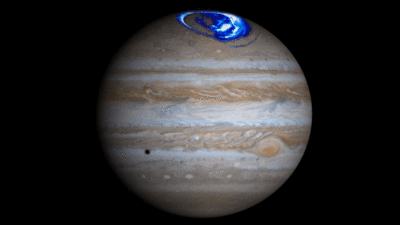In 1975, two University of South Florida astronomers (Ray S. Clary and James H. Hunter Jr.), published their paper ('Hydrogen Alpha Auroral Activity on Jupiter') on the attempted detection of auroral activity on Jupiter in The Astrophysical Journal (Vol. 199, p. 517). They noted correctly that given the correlation between Jupiter's radio emissions and solar outbursts nonthermal, visible emissions from the planet ought to have been detected.
They then documented a brief history of such efforts by reference to the narrow passband H-alpha filters used and noted that "intense auroral activity should have increased the narrow passband channel's output". However, in most of these efforts the aperture of the telescopes used were not adequate to detect substantial localized activity,
When the 84 -inch Kitt Peak telescope was finally used by Dulk and Eddy (Astronomical Journal, Vol. 71, p. 160, 1966), paired with a coude spectrograph of 0.1 A resolution," no evidence for activity greater than 1.2 kilorayleighs was found". In a different observation, a possible H-alpha feature was found but the author (Schwitters, Icarus, 1968, Vol. 9, 570) )admitted it may have arisen from a plate defect.
With this history, the USF astronomers then attempted their own H-alpha detection using the university's 26-inch Schmidt -Cassegrain telescope. Most importantly, they noted that:
"At least the polar areas should be visible since aurorae should be most likely there"
They carried out their observations from April through November, 1972 "usually with Jupiter 2 hours or less from the meridian". This would have ensured the optimal seeing conditions since Jupiter's altitude would be displaced enough from the horizon to avoid atmospheric effects, and enable the greatest clarity.
The pair ended up making a total of 100 hours of observation yielding some 2,000 photographs of Jupiter, most of them prior to the planet's opposition on June 24 of that year. Still "observations were often interrupted by clouds or haze"
Alas, the results themselves were ambiguous. Examining their prime plates published in their paper (4 pages in all) I could detect nothing remarkable or any features that stood out - even in the polar areas- and which could have been identified with auroral activity. In their own stated words, for 'Results and Conclusions' the authors wrote:
"Most of the pictures (> 90 percent) taken in H-alpha during the experiment showed no significant detail on the 'surface' of Jupiter."
They added that:
"Equatorial features should have been resolved if they were visible. Haze and /or clouds reduced the resolution and brightness of images and it was frequently necessary to discontinue an observing run."
Their results, such as they were, had been attributed to one of two interpretations:
1) Apparent variations in Jupiter's emissions were observed but the effects must be deemed spurious doe to conditions at the observing site, and
2) A general, nonlocalized, H-alpha airglow was observed that was sufficiently intense to prevent observation of familiar Jovian features given the airglow strength was 3-5 kilorayleighs.
In other words, (2) meant the airglow emission strength likely wiped out any residual auroral signal.
While Clary's and Hunter's observational effort represented a determined 'experiment' to detect H-alpha emissions, it also showed the limitation of ground -based observations for a delicate optical feature presumed to exist on a distant planet. No surprise then that the actual detection of Jovian aurorae had to await the observations of the Hubble Space Telescope launched some 30 years later. One such image from the HST is shown below:

Image of Jupiter aurorae using Hubble Space Telescope
Interesting, and unknown to the USF astronomers at the time, Jupiter's aurora occurs mostly in the ultraviolet (UV) part of the spectrum. Still, analogous to Earth's aurorae, Jupiter's are caused by showers of energetic particles, e.g. from the solar wind, raining down on the upper atmosphere, exciting atoms and causing them to glow.
Recent research by Gerard et al (Journal of Geophysical Research - Space Physics, 2014) goes one step further and also shows how energetic these incoming particles (mostly electrons) are using one of the Hubble's spectrographs. They found the most energetic incoming electrons penetrate the deepest into Jupiter's atmosphere producing a UV emission closer to the surface.
To map these more energetic electrons (as shown above) the Gerard team panned Hubble's 'eye' across the disk of Jupiter at a constant rate and used a special mode of the spectrograph that tags every bit of light detected with a time stamp. In this way they could later reconstruct which emission came from which part of the planet.
These maps could very well provide insight into one of the planet's most enduring mysteries: why its upper atmosphere is so hot. Decades of measurements show that Jupiter's atmosphere contains much more heat than would be expected if its only source was incoming solar radiation. The energy deposition maps show that the aurorae may play a role in this extra heating given the amount of energy the electrons deposit in the upper atmosphere is enormous - on the order of 10 terawatts, the equivalent of about 10,000 nuclear reactors. This is vastly greater than the energy Jupiter absorbs from the Sun.
A pity that my former USF colleagues didn't have available then what the Gerard team and others have had since Hubble achieved orbit.
No comments:
Post a Comment